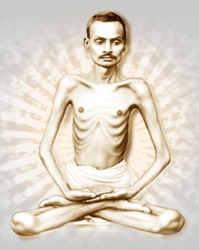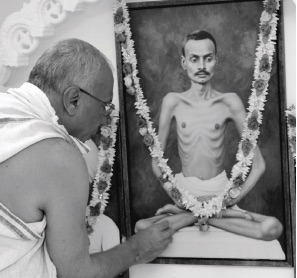 2500 years ago, the 24th great teacher of the Jains, Mahavira, attained nirvana (release from the cycle of birth and death). Since then, several enlightened souls have expounded the philosophy of Jainism. One such exalted soul was Shrimad Rajchandra. He is deeply venerated for the great spiritual heights He had attained, his outstanding personality, His remarkable exposition of Mahavira’s teachings and His literary genius.
2500 years ago, the 24th great teacher of the Jains, Mahavira, attained nirvana (release from the cycle of birth and death). Since then, several enlightened souls have expounded the philosophy of Jainism. One such exalted soul was Shrimad Rajchandra. He is deeply venerated for the great spiritual heights He had attained, his outstanding personality, His remarkable exposition of Mahavira’s teachings and His literary genius.
Shrimad Rajachandra
9 November 1867 – 9 April 1901 (aged 33)
Shortly after his return from England, Mahatma Gandhi met a young man of 25 in Mumbai who was to have a profound influence on his life and philosophy.
To quote Gandhi: “Since that day onwards till the death of Raichandbhai, ours was a very close contact. Many times I have said and written many times that I have learnt much from the lives of many a person, but it is from the life of poet Raichandbhai, I have learnt the most” and “I must say that no one else has ever made on me the impression that Raichandbhai did”.
Raichandbhai, to be known as Shrimad Rajchandra, composed the ‘Atma Sidhi Shastra’, a composition of 142 stanzas explaining the Jain path to liberation (Moksha), one night in Nadiad in just 90 minutes. This highly spiritual composition is also considered Classic Gujarati Literary work.
So who was the self-realised Raichandbhai who had such impact upon Gandhiji, and in consequence the whole world? Was he just a poet, a dealer in precious stones, or a spiritual genius?
Ravjibhai (from a Vaishnav background) and his wife Devbai (from a Jain family) lived in the small port of Vavania near Morbi in Saurashtra, India. They were a devout couple who served the community with much love and in 1867 they were blessed with a son whom they named Raichand.
Raichand was later to be known as Shrimad Rajchandra and considered to be Gandhi’s spiritual mentor. It was from him that Gandhi learnt the height of compassion for all living beings, even an enemy!
Shrimad’s mother was a model of humility and service such that, even though the family’s financial position was poor, Devbai continued to serve monks, saints and all visitors to her home with the same generosity and affection.
Recalling past lives
When he was only seven, an elder and fond friend, Amichandbhai, died of a snake bite. Being inquisitive, Raichand inquired into the death and was told that the ‘life’ had passed out of Amichandbhai, and that, as he would no longer speak or do anything, he would be cremated. The 7-year-old clambered up a tree near the cremation ground and watched the proceedings.
As he pondered deeply about what he saw, and wondered why someone would cruelly burn a man, suddenly he felt as though a veil had been removed. It is at this point he experienced ‘Jati Smaran Gnaan’, knowledge of past lives. Re-incarnation had now become a direct experience for him!
A small temple stands today at the site of the tree, although the tree itself no longer stands.
Education
Though he started school late at the age of seven, he mastered the preliminaries of Mathematics in a month. Commanding great respect from fellow students and teachers, he was even allowed to conduct a class under the teacher’s supervision. He used his photographic memory extensively, remembering the lessons at one reading.
Even at this early age he showed great determination and commitment, completing the curriculum of seven standards in just two years. He started his career in poetry early at the age of eight, writing about a thousand stanzas in the first year and composed poetry on the classics ‘Ramayana’ and ‘Mahabharat’ when he was only nine. Already contributing articles to Newspapers and Magazines from the age of eight, he wrote 300 stanzas on ‘A Watch’ at twelve.
Being the recipient of numerous prizes for writing essays and poetry, he was well regarded as a great poet and scholar. One of his very early poems of a patriotic nature is sung in schools in Gujarat even today.
Having demonstrated a clear comprehension of his goal in life Shrimad’s formal education ended at the age of twelve when he started attending his father’s shop.
Writings

Moksha
Shrimad retired early and was ready to renounce the world (take Diksha) but, poignantly, was afflicted by a severe illness which prevented the realisation of this vision. During his illness he kept to the study of religious texts which is reflected in his letters.
Because of his love for the teachings and his longing for a spiritual revival, he continued to spread the message to monks and householders despite his ill-health. That he would work so hard despite being weak due to illness speaks volumes for his compassion! Even though he was so weak that he could not even sit up by himself, he was totally alert and aware.
Finally, at age 33, on 9th April 1901 CE, at 8:45 AM, after requesting his brother Mansukhbhai to take care of their mother and completely detaching himself from the outside world, he withdrew within and passed away at 2 PM
Legacy
Rajchandra was inspired by works of Kundakunda and Digambara mystical tradition and, in turn, inspired several spiritual teachers and followers including people from all schools of Jainism. His followers sometimes consider his teaching as a new path of Jainism, neither Svetambara (white clad) nor Digambara (sky clad), and revere him as a saint.
The Government of India released ₹10 coins, ₹150 souvenir coins and the stamps at the Sabarmati Ashram in Ahmedabad on 29 June 2017 as the commemoration of Shrimad Rajchandra’s 150th birth anniversary.
Mandal (Organisation)
There is an international organisation that carries on the teachings and works of Shrimad Rajachandra. (Called mandal in India.)
The organisation goes by the name, Shree Raj Saubhag Satsang Mandal. The foundation of the Ashram lies in the thread of truth that connects the lineage of self realised souls throughout time. These enlightened souls illuminate the inner path which removes delusional ignorance to enable the experience of one’s soul. This inner path shown by Tirthankar Mahavir remains hidden from the outward mind. Yet the path surfaces over time in the hearts of those that have experienced the soul. Param Krupaludev Shrimad Rajchandra and Shree Saubhagbhai were two such saints. In their compassion, they illuminated this path so that the thread of truth remains unbroken. They form the very foundation for the inner path at Shree Raj Saubhag Satsang Mandal.

Summary of Atma Sidhi Shashtra
The Soul Exists
The soul appears the same as the body due to the illusory identification with the body; but both are distinct like a sword and its sheath. It is of the nature of pure consciousness.
The Soul is Eternal
Knowledge of the birth and death of the body cannot arise unless the entity experiencing the knowledge is different from the object. Nothing can create or destroy the soul; thus, it is eternal.
The Soul is the Doer of Karma
If the soul remains conscious of its true self, it acts in tune with its nature; if it does not remain conscious of its true self, it becomes the doer of karma. The body, or lifeless matter, has no capability to acquire karma. The soul is the acquirer of karmic bondage.
The Soul is the Bearer of Consequences
Poison and nectar have no understanding to affect anyone, but one who consumes them gets affected; similarly, the soul bears the consequences of its meritorious or unmeritorious karma. God does not give the fruits of its actions.
The Soul can be Liberated
There is freedom from the bondage of karma. With the ultimate dissociation of the soul from the connection with the body, it eternally stays in the liberated state and experiences its own infinite bliss.
There is a Path to the Soul’s Liberation
The means through which one can realise the pure ever-lasting conscious soul, constitutes the path of liberation. Delusion prevailing from infinity is annihilated with the advent of enlightenment.
![]()

